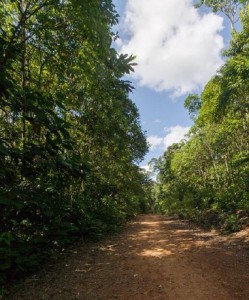Share this article
In the Amazon rainforest, small roads have big impacts
Cars, trucks, and other vehicles leave noise, pollution, and roadkill in their wake. But if those impacts are subtracted, what about the roads themselves?
“We wanted to untangle the effects of a road from the effects of driving vehicles on that road,” says U.S. Forest Service scientist Daniel Saenz. The issue is especially important in the Amazon rainforest, where an estimated 160,000 miles of road already exist. “Very little research has been done on how these roads could affect wildlife,” says Saenz.

This unpaved, little-used road had a significant impact on reptiles and amphibians. ©Ross Maynard, Stephen F. Austin University, CC 4.0
Saenz and his colleagues recently conducted a study on road effects on amphibians and reptiles in the Amazon rainforest at San José de Payamino, Ecuador. The study was published in Tropical Conservation Science, and led by Ross Maynard. Maynard is currently a biologist at The Biodiversity Group, but in 2014, when research for the study was being conducted, he was one of Saenz’s students at Stephen F. Austin State University in Texas.
The study took place in the Kichwa community of San José de Payamino, Ecuador. “Less than 10 years ago, the Payamino community was isolated, and to reach the nearest towns, people had to travel via river,” says Saenz. “That has changed – there have been a number of dirt roads built within the past decade.”
The road Saenz and his colleagues studied was built in 2010, but the absence of a bridge over a tributary of the Payamino River, as well as erosion, makes it largely inaccessible to vehicles. However, people frequently travel the road by foot.
Saenz and his colleagues sampled the reptile and amphibian communities in a 360 foot-wide buffer along both sides of the road. The scientists also measured habitat characteristics such as the depth of leaf litter, the density of the understory, and the abundance of vines and mature trees.
“We found that this small, dirt road had a profound effect on amphibians and reptiles,” says Saenz. “Abundance and diversity were significantly lower near the road.” The community composition of amphibians was also affected, and the changes extended 330 feet from the road’s edge.
Some of the frogs and toads found near the road typically live in undisturbed areas. However, these species were usually found on or near old growth trees that were still growing near the road. Whether or not such trees can survive next to a road, with its warmer temperatures and lower humidity, is unknown.
Areas with a large amount of vines tended to have fewer amphibians. Other studies have found this as well. In the tropics, vine abundance usually precedes tree decline, and also indicates that a forest has been disturbed. Vines change the structure of the forest considerably, and probably change the availability of resources, too. “These differences likely have a profound impact on amphibian distribution patterns,” says Saenz.
Reptile abundance was also related to the amount of vines in the study plots, as well as the amount of trees. “We were surprised to find more reptiles in the interior forest than at the forest edge,” says Saenz. “We expected reptiles to be more tolerant of the sunnier, warmer, forest edge.”
Sampling reptiles in tropical forests is challenging, and Saenz and his colleagues suggest that using two survey methods and sampling reptiles at night and in the daytime could help. However, the tropical forests near Payamino are home to such spectacular biodiversity that single-site survey efforts spanning nearly 30 years continue to record new species. Tropical forests cover about 7 percent of the Earth’s surface, and contain roughly 50 percent of the world’s species.
Unpaved roads usually have a smaller ecological footprint than paved roads. However, Saenz and his colleagues found that a relatively obscure unpaved and undrivable road had profound impacts on amphibians and reptiles. “Minimizing such disturbances will help protect local wildlife at Payamino,” says Saenz. “Native flora and fauna are closely tied to the livelihoods of indigenous peoples throughout Amazonia, including the Kichwa community of Payamino. Protecting the natural integrity of biotic communities as much as possible should be a priority.”
Read the full text of the article.
For more information, email Daniel Saenz at dsaenz@fs.fed.us.
This article originally appeared on CompassLive, the online science magazine of the U.S. Forest Service Southern Research Station (SRS). View the original article here.
Header Image: During the course of the study, the scientists found a new species of glass frog. It belongs to the genus Hyalinobatrachium and was found away from the forest edge. The frog is currently being described by Ross Maynard and his colleagues. ©Ross Maynard, The Biodiversity Group








